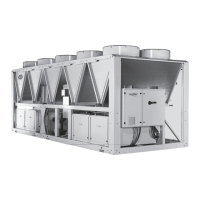26
8. Install three 1/4-20 x 1-in. hex head machine screws
(P/N: AC67AP170) through the holes in the rotor. Tighten
to 50 in.-lb (5.65 Nm)
9. Align holes of composite fan inlet casing with screw wells on
the top flange of the fan stator.
10. Final assembly should have a small clearance between top
of plastic rotor and underside of casing lip. Spin rotor by
hand to ensure no contact or rubbing between these two
parts. Insert four screws (P/N: AP13AD128) and tighten to
14 in.-lb (1.58 Nm).
Reinstalling Motor and Fan Assembly
1. Reassemble the motor assembly to the fan deck.
2. Reinstall the quarter round plates and tighten the screws
3. Align motor harness/grommet aligned with the control box
4. Slide the fan deck back into the unit assembly
5. Re-install the six retainer screws
6. Reconnect wires for stator temperature limit switch.
7. Pull motor harness tight through grommet and plug it in to the
control box harness and secure in the corner with snap-in
wire tie.
Condensate Drains
Keep condensate drains free of dirt and foreign matter.
Return-Air Filters
Refer to Replacing Filters section on page 26 for filter accessibili-
ty and removal. Replace with clean filters of the sizes listed in
Tables 1-3.
Chilled Water Coil Freeze Protection
Shut off water supply to unit. Remove side panel of unit and
remove vent and drain plugs in top and bottom of coil header.
Drain coil and blow out remaining water. Reinstall plugs and side
panel. Alternative freeze protection methods follow:
• Circulate hot water within the water coil’s supply main or
supplementary space heating.
• Close off supply lines to unit and open a union or field-
supplied drain valve in the return line.
• After draining as much water as possible from coils, add
sufficient antifreeze to prevent residual water in the coil
from freezing.
• Add a sufficient quantity of non-corrosive antifreeze to the
entire system to prevent all water within the system from
freezing.
Coil Removal
Remove unit panels and corner posts as required. Disconnect coil
connections and remove fastening screws. Remove coil through
end or side sections of unit.
Cleaning Cooling Coil
Remove return-air filters. Remove any heavy dirt that may have
accumulated on underside of coil. Coil can be cleaned more easily
with a stiff brush, vacuum cleaner, or compressed air when coil is
dry. If coil is wet or if water is to be used for cleaning, guard
against splashing water on electrical components or damaging
surrounding area. Clean coil baffles as applicable and check for
tight fit to be sure air does not bypass coil.
Cleaning Insulation
The insulation contains an immobilized antimicrobial agent that
helps inhibit the growth of bacteria and fungi. Clean the inner sur-
face of the insulation according to the separate maintenance
instructions shipped with the unit.
Replacing Filters
Filters can be removed and installed from either side of the unit.
Install new filters in units that have one fan as follows:
1. Remove the side access panel (retain screws).
2. Remove the filter retainer clip (see Fig. 34).
3. Remove old filters by lifting and tilting them out of the filter
track. (See Fig. 14 and 35.)
4. Reverse the procedure to install new filters.
To install new filters in larger units that have 2 fans, follow the
preceding steps, but use the factory-supplied filter hook to slide
filters within reach for removal. The filter hook is shipped inside
the unit in the filter track.
Fig. 34 — Remove Filter Retainer Clip
IMPORTANT: Draining from return line will not completely
drain water from coils.
CAUTION
EQUIPMENT DAMAGE HAZARD
Failure to follow this CAUTION can result in premature wear
and damage to equipment.
DO NOT OPERATE THE UNIT WITHOUT THE RETURN
AIR FILTERS IN PLACE.
Dirt and debris can collect on heat exchangers and coils
possibly resulting in a small fire. Dirt buildup on components
can cause excessive current used resulting in motor failure.
Slide
Filter
Retainer
Clip

